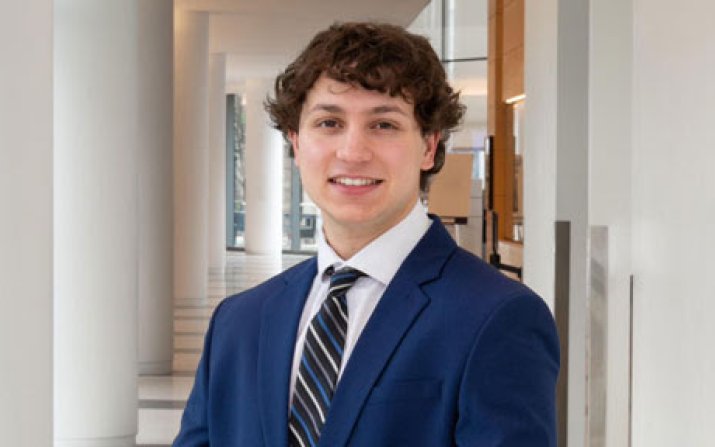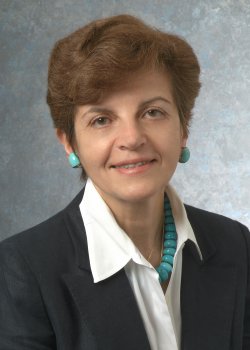Spartan Showcase: Jake Grondz

Jake Grondz’s research career started with an email. In search of a lab to call home, Grondz began reaching out to principal investigators in materials research at Case Western Reserve University. That’s what introduced him to Ica Manas-Zloczower, Distinguished University Professor and the Thomas W. and Nancy P. Seitz Professor of Advanced Materials and Energy, and her team’s work on thermoplastic polyurethane (TPU).
Now a rising fourth-year student majoring in chemical engineering, Grondz has spent years working on the properties of this widely used material, which has applications in the automotive, aerospace, manufacturing and footwear industries.
In addition to his classwork and research endeavors, Grondz spent two years on the CWRU football team.
“I am very grateful for the opportunities, relationships, and skills that CWRU has given me over the past few years,” he said. “I have grown tremendously in all aspects of my life while at Case, and it is definitely a time of my life that I will remember forever.”
Learn more about Grondz’s time at CWRU.
Answers have been lightly edited for clarity and length.
1. What drew you to Case Western Reserve University?
I first became interested in CWRU after being recruited to play football here. From there I began to investigate what Case [Western Reserve] is and what they have to offer. I then became drawn in by their remarkable engineering program, small class atmosphere, excellent reputation, great location, and very strong alumni base. After this, Case [Western Reserve] quickly became my top option.
2. Why did you choose your area of study?
I chose to be an engineer because I have strong science and math skills and I ultimately enjoyed solving problems and improving aspects of the world around us. I specifically chose chemical engineering firstly because I enjoyed chemistry the most out of any science subject.
But, on a deeper level chemical engineers are incredibly versatile, working in virtually every industry. They have a unique ability to end up in any role they desire throughout their career. This comprehensive skill set and range of career opportunities piqued my interest.
3. What do you enjoy most about it?
I truly enjoy the problem-solving aspect of chemical engineering and its applications. I love learning about how the principles and equations we cover in class relate to real world applications and are ultimately used to make our world a better place. This is something that constantly comes up in chemical engineering throughout my classes, research, and internship experience.
For example, in my Process Control class with Dr. [Heidi] Martin, my group worked on a design project to develop a machine that could control the viscosity of whipped cream and serve the desired texture every time. In using the principles of transport and fluid dynamics, with a little math, this idea came to life and served as a prime example of how engineers can impact daily life.
4. Can you briefly describe your research topic?
My research over the past few years has covered multiple topics on the subject of polymer development, specifically TPU. Our research aims at tackling a common problem with these materials: their high temperature instability and reprocess-ability.
By use of various techniques including controlled crosslinking, annealing, and filler addition, we were able to make significant progress in improving the high temperature resistance and overall mechanical properties of these materials. I am currently working with my colleagues on finishing up two publications on these findings, that will highlight this revolutionary work.
5. What do you hope will come from this research?
At the end of the day, I hope that this research reaches eyes that would use the findings to improve the current materials used commercially today. This means a lot for research scientists, because ultimately these findings are not very significant without true applications.
For example, if we can improve the temperature resistance and recycle-ability of TPU, there would be significantly less failures of TPU parts, and as a result, much less material used and decreased costs in replacing these parts with new ones. Knowing this, we strive to emphasize and display the application potential in every project we work on.
To achieve this, we currently work with Parker Hannifin Corp., which is one of the largest producers of TPU parts worldwide. Our group has seen much of our work being used and scaled to their applications already and we aspire to continue this partnership to see more of our work be applied in the future.
6. After undergrad, what are your aspirations?
After graduating this spring, I aspire to begin work as a full-time materials research scientist. I have not made any commitments yet, but I aim to work near home (the San Francisco Bay area). Additionally, I plan to complete a master’s degree, in polymer science, in the near future (while working).
In terms of long-term career goals, I aspire to make significant achievements in the polymer world that would improve their application potential and useability across many industries. I believe that God has called me for this path, that would hopefully positively impact the lives of many.
7. Are you involved on campus in any other ways?
Yes, I currently help lead and organize a weekly Christian Bible study group on campus called Case for Christ. I have been a part of this group for three years now and have made some strong relationships and grown in my faith over this time. We are always open to new members, from any background!
Additionally, I was a member of the CWRU varsity football team for two years. This was an incredible experience for me, teaching my discipline, work ethic, and how to compete respectfully in all aspects of life. I’ve also developed some very strong relationships through playing football at CWRU, which I will take with me for the rest of my life.
8. Have you had any internships, volunteer positions or other experiential experiences?
I have interned at Lawrence Livermore National Laboratory (LLNL), in Livermore, California, for two summers. My work there entails silicone formulation development with emphasis on direct ink writing 3D printing applications.
This has been a remarkable work experience for me, as I’ve gained many new skills, worked on very significant and important projects, and made great relationships. I do not believe that there is any place to work like LLNL. From the work environment to my projects to the incredible resources and technology that LLNL has, I truly enjoyed my time there and hope to continue in the future.

